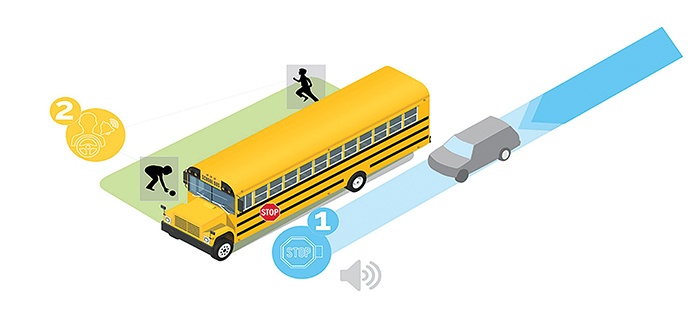
By Deirdre O’Brien
Technology and grassroots efforts join forces to increase safety outside the bus
Students outside the school bus are far more vulnerable to risk of injury than those on-board the bus. And the risk to students outside the bus is rising every year, according to annual injury statistics. The 2018-19 school year saw 70 injuries and 17 fatalities related to school bus crossings. The 2019 NASDPTS survey on illegal school bus passing conducted across 39 states showed 130,963 school bus drivers reported 95,391 motorists had illegally passed a stopped school bus in a single day. With roughly 471,000 school buses in service in the US, this equates to over 340,000 illegal school bus passes per day and 62 million illegal passes per school year.
Motorist distraction and a lack of concern for the rules of the road
Experts suggest we are dealing with a combination of motorist distraction and disinterest in observing rules and regulations. Motorists can be distracted by mobile phones, passengers, and other tasks/problems on their mind. Impairment, another form of distraction, arguably presents the most risk and a high level of unpredictability. Drivers who are indifferent to the rules of the road and how they operate their vehicles in the vicinity of a school bus present a completely different dilemma. How do you influence those who aren’t motivated to obey the law?
We have been trying to tackle this critical issue as an industry for years. Awareness and education programs, stop arms, crossing gates, and cameras have each helped reduce student injury and improve safety. But to get the number of children affected in school transportation-related accidents closer to zero, we need to acknowledge that any tool, technology, or awareness program that relies on human attention alone may not achieve perfect results. Today’s environments relentlessly challenge the focus and attention of every driver on the road. All signs point to an increase in these challenges, not a reduction in them.
Applying intelligent technologies and innovative thinking to a long-standing issue
Roadways are becoming busier and distraction and other forms of driver inattention are on the rise. Should we continue to approach the problem using the same methods?
These tactics have effectively reduced an element of risk. Perhaps we couple these traditional methods with intelligent technologies that eliminate blind spots and issue visual and audible alerts to school bus drivers and those who are at risk, the students themselves?
At Safe Fleet, we believe Artificial Intelligence is the glue that brings the value of each individual safety tool – mirrors, video, and sensors – together, for a complete view of what’s going on. Not just detecting, but also providing a frame of reference. This might come in the form of an alert that tells the driver where the problem is, (for example – rear, right side of the bus) which could also be coupled with different alarms or spoken word, such as ‘child,’ or ‘car.’ Bringing intelligence into the safety mix adds clarity and the ability to respond quickly and confidently.
For example, school districts could employ technology that uses radar and predictive analytics to monitor oncoming vehicle traffic for probable stop arm violations. This technology would work alongside stop arm camera systems, mirrors and crossing arms. Each tool or system would play its role in protecting the child, but when danger is present, those who are at risk – the students, are notified by the advanced technology to stay back. This innovative approach alerts the students to take immediate and life-saving action. It helps keep students from entering into the Danger Zone in the first place.
There is also a strong case for intelligent 360° systems that provide a complete overhead view of the perimeter of the bus coupled with object detection functionality. The bus driver is provided with a passive, blind-spot-free view of their surroundings along with an active alert system to aid the driver in taking faster and more responsive action when danger is present.
This approach to adding intelligence to safety equipment helps identify what is important and ignore what is not.
Changing the High-Risk Narrative
Education, awareness, and accountability should always play a role in fostering student safety. It is easier to correct unwanted behavior when the expected and desired behaviors are fully understood and when unwanted behaviors are discouraged with active and consequential repercussions. Grassroots programs that educate and encourage desired outcomes should remain an integral part of any Danger Zone student safety program.
The ultimate goal is an environment where stop arm violations are not the norm. Until we reach this goal, intelligent technology and new ways of thinking can reduce risk to students in the Danger Zone almost as soon as these systems are implemented. Long term, the most effective way to reduce the risk to students from stop arm violations, and address distracted driving and the lack of awareness and/or a disregard for the rules, is an approach that encompasses all of these methods.
Safe Fleet has a vision to reduce preventable deaths and injuries in and around fleet vehicles, with a goal of ZERO accidents. To this end, Safe Fleet has developed the Predictive Stop Arm™ a patented solution that uses radar technology and predictive analytics to monitor oncoming vehicle traffic, measuring vehicle speed and distance from a school bus. Analytics algorithms process data from radar sensors and determine whether a vehicle has sufficient time to slow down and stop or whether a stop arm violation is probable. If the system perceives that a student should not cross, the student will hear “Danger, Get Back,” emitted from speakers mounted outside the bus and the bus operator will receive a visual alert inside the bus.
Deirdre O’Brien is senior content specialist for Safe Fleet. Contact Safe Fleet to learn more at www.safefleet.net.


